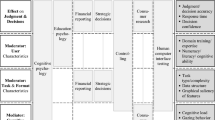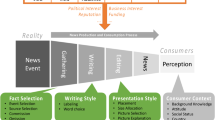Abstract
With the growth of hierarchical data in public opinion analysis, new visualization methods that can intuitively present this kind of data are urgently needed. In this paper, we propose VineMap, a new visualization method with a vine metaphor form. Different from other public opinion visualizations, we devote more attention to visualize both the hierarchical structure of texts and the semantic orientation in content. First, we extract a hierarchical topic model from text data. Then we design a visualization based on a vine metaphor form to enable users to understand public opinion in hierarchical form. At the same time, we propose heuristic optimized strategies for the visualization layout. VineMap is applied both on unstructured text data and structured data to demonstrate its applicability. The evaluations not only show users’ perceptions to our method but also prove its good performance with respect to generation time, space utilization and visual effect.
Graphic abstract












Similar content being viewed by others
References
Bjørkelund E, Burnett TH, Nørvåg K (2012) A study of opinion mining and visualization of hotel reviews. In: Proceedings of the 14th International Conference on Information Integration and Web-based Applications & Service, pp 229–238
Blei DM, Griffiths TL, Jordan MI, Tenenbaum JB et al (2003) Hierarchical topic models and the nested Chinese restaurant process. In: NIPS, vol 16 MIT Press, pp 17–24
Bonnardel N, Piolat A, Bigot LL (2011) The impact of colour on website appeal and users’ cognitive processes. Displays 32(2):69–80
Calderon F, Chang CH, Argueta C, Saravia E, Chen YS (2015) Analyzing event opinion transition through summarized emotion visualization. In: Proceedings of the 2015 IEEE/ACM International Conference on Advances in Social Networks Analysis and Mining, pp 749–752
Dang T, Forbes AG (2017) Cactustree: a tree drawing approach for hierarchical edge bundling. In: 2017 IEEE Pacific Visualization Symposium (PacificVis), pp 210–214
de Vienne DM (2016) Lifemap: exploring the entire tree of life. PLOS Biol 14(12):1–8. https://doi.org/10.1371/journal.pbio.2001624
Dou W, Yu L, Wang X, Ma Z, Ribarsky W (2013) Hierarchicaltopics: visually exploring large text collections using topic hierarchies. IEEE Trans Vis Comput Graph 19:2002–11. https://doi.org/10.1109/TVCG.2013.162
Graham M, Kennedy JB (2010) A survey of multiple tree visualisation. Inf Vis 9(4):235–252
Holten D (2006) Hierarchical edge bundles: visualization of adjacency relations in hierarchical data. IEEE Trans Vis Comput Graph 12(5):741–748
Hoque E, Carenini G (2016) Multiconvis: a visual text analytics system for exploring a collection of online conversations. In: Proceedings of the 21st international conference on intelligent user interfaces, pp 96–107
Huron S, Vuillemot R, Fekete J (2013) Visual sedimentation. IEEE Trans Vis Comput Graph 19(12):2446–2455
Kamal A (2015) Review mining for feature based opinion summarization and visualization.
Li Y, Li D, Zhang K (2017) The impact of metaphors on information visualization. J Vis 20(3):487–504
Liu C, Wang P (2015) A sunburst-based hierarchical information visualization method and its application in public opinion analysis. In: 2015 8th International Conference on Biomedical Engineering and Informatics (BMEI), pp 832–836
Mohsen AM, Idrees AM, Hassan HA (2019) Emotion analysis for opinion mining from text: a comparative study. IJeC 15(1):38–58
Molla A, Biadgie Y, Sohn K (2014) Network-based visualization of opinion mining and sentiment analysis on Twitter. In: 2014 In ternational Conference on IT Convergence and Security (ICITCS), pp 1–4
Rao Y, Lei J, Wenyin L, Li Q, Chen M (2014) Building emotional dictionary for sentiment analysis of online news. World Wide Web 17(4):723–742
Rosindell J, Harmon LJ (2012) Onezoom: a fractal explorer for the tree of life. PLoS Biol 10(10):e1001-406
Rostami MA, Azadi A, Bücker HM (2014) A new approach to visualizing general trees using thickness-adjustable quadratic curves. In: Graph drawing. Springer, p 525
Sallaberry A, Fu YC, Ho HC, Ma KL (2016) Contact trees: Network visualization beyond nodes and edges. PLoS ONE 11(1):e0146–368
Schulz H (2011) Treevis.net: a tree visualization reference. IEEE Comput Graph Appl 31(6):11–15
van den Elzen S, van Wijk JJ (2011) Baobabview: interactive construction and analysis of decision trees. In: IEEE VAST. IEEE Computer Society, pp 151–160
Wu Y, Wei F, Liu S, Au N, Cui W, Zhou H, Qu H (2010) Opinionseer: interactive visualization of hotel customer feedback. IEEE Trans Vis Comput Graph 16(6):1109–1118
Yu B, Funk M, Hu J, Feijs LMG (2017) Stresstree: a metaphorical visualization for biofeedback-assisted stress management. In: Conference on designing interactive systems. ACM, pp 333–337
Yu D, Xu D, Wang D, Ni Z (2019) Hierarchical topic modeling of Twitter data for online analytical processing. IEEE Access 7:12373–12385
Acknowledgements
This work was partly supported by National Natural Foundation of China (Nos. 61802128, 61672237, 61532002).
Author information
Authors and Affiliations
Corresponding author
Additional information
Publisher's Note
Springer Nature remains neutral with regard to jurisdictional claims in published maps and institutional affiliations.
Supplementary Information
Below is the link to the electronic supplementary material.
Rights and permissions
About this article
Cite this article
Cui, Y., Li, C., Chen, C. et al. VineMap: a metaphor visualization method for public opinion hierarchy from text data. J Vis 24, 1097–1111 (2021). https://doi.org/10.1007/s12650-021-00757-z
Received:
Revised:
Accepted:
Published:
Issue Date:
DOI: https://doi.org/10.1007/s12650-021-00757-z




